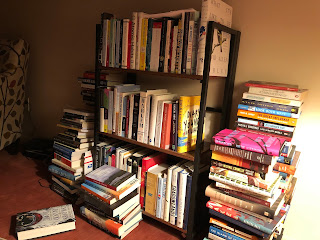48. Robert Macfarlane and Jackie Morris, illustrator, The Lost Spells (2020) (9/29/21)
A while back I read a beautiful book called The Lost Words, by this same author and illustrator. I was enchanted. The descriptive poetry was lovely, the illustrations exquisite.And so I bought their newest book—which I very much liked, but it was a little less of a love affair. One reason was, that first book was such a wonderful surprise: I had no idea what I was getting into when I cracked that cover. But also, I adored the very large format of the first book, while this, as the inside jacket itself says, is "its little sister." It's small! To be held in your hand, perhaps tucked in a daypack that you take out into the world. The last many pages of this book, indeed, are a "glossary"—an identification key to all the many animals and some plants tucked into its pages, and that are out in the world to be found.
The poetry is, again, wonderful, and often I was struck by the way the words, in their rhyme or their rhythm, captured the essence of the thing being described: Red Fox, Moth, Daisy, Jackdaw, and on and on. This book felt a little more "adult" than The Lost Words for some reason. Not a bad thing. It is a book about rewilding our lives, about noticing the magic all around us, about summoning up incantations to keep that wildness alive. These spells feel very necessary in today's world.
I would love to see an exhibition of all the beautiful, beautiful watercolors, in their original manifestation. Here are a few of them:
And here is a conversation with Macfarlane and Morris about this book:
Now I think it's about time I actually sat down and read one of Macfarlane's books for adults. Or at the very least I should make more of a point of checking him out more regular-like on Twitter.
Finally, here's a great conversation between Macfarlane and On Being's Krista Tippett. Toward the very end, at about 42:00, he talks a bit about The Lost Words and then he reads a bit from The Lost Spells. Delightful!


















































